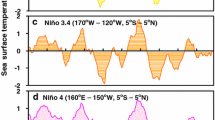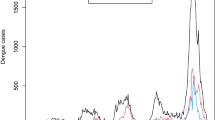Abstract
This study investigates the impact of future changes in climatic variables on dengue incidence in the region of the Tucurui dam in the Amazon. Tucurui dam is the one of the largest hydroelectric power stations in the Amazon. Correlations and regression analysis through least squares fitting between dengue cases and temperature, precipitation, and humidity are obtained. Positive correlations between dengue incidence and temperature are found for lags from 4 to 5 months (higher correlation for lag 5), dengue and precipitation for lags 0 up to 1, and dengue and humidity for lag 0. The positive correlations between dengue and precipitation and between dengue and humidity are higher for the simultaneous correlation. To investigate the impact of the future changes in these climatic variables in the region, projections of RegCM4 model simulations under the RCP 8.5 scenario are obtained. The model projections indicate a warming and moisture increase in the region near the dam at the end of the twenty-first century. Regression analysis using the model projections indicates that the dengue incidence may increase substantially in future climate scenarios in this region (more than fivefold compared with the present climate). This increase is between two and three times higher than the global estimates of dengue incidence in the future. It is suggested that the incidence of dengue cases is more sensitive to changes in temperature. Vector parameters increase with temperature in the future, indicating that the temperature conditions are highly favorable for the spread of the disease in the region. The results indicate that cities in the area surrounding the Tucurui hydroelectric dam are areas of potential dengue incidence in the future. These findings may be applied to hydroelectric dams in other areas of the world. However, future studies involving additional dams are necessary. The results suggest an increase in climate-driven risk of transmission from Aedes aegypti throughout the entire Amazon, and especially the eastern and southern parts.









Similar content being viewed by others

References
Alto, B. W., & Bettinardi, D. (2013). Temperature and dengue virus infection in mosquitoes: Independent effects on the immature and adult stages. The American Journal of Tropical Medicine and Hygiene, 88, 497–505. https://doi.org/10.4269/ajtmh.12-0421 PMID: 23382163.
Andraud, M., Hens, N., & Beutels, P. (2013). A simple periodic-forced model for dengue fitted to incidence data in Singapore. Mathematical Biosciences, 244, 22–28. https://doi.org/10.1016/j.mbs.2013.04.001 PMID: 23608712.
Chen, S. C., & Hsieh, M. H. (2012). Modeling the transmission dynamics of dengue fever: Implications of temperature effects. Science of the Total Environment, 431, 385–391. https://doi.org/10.1016/j.scitotenv.2012.05.012 PMID: 22705874.
Chen, S. C., Liao, C. M., Chio, C. P., Chou, H. H., You, S. H., & Cheng, Y. H. (2010). Lagged temperature effect with mosquito transmission potential explains dengue variability in southern Taiwan: Insights from a statistical analysis. Science of the Total Environment, 408, 4069–4075. https://doi.org/10.1016/j.scitotenv.2010.05.021 PMID: 20542536.
Chikaki, E., & Ishikawa, H. (2009). A dengue transmission model in Thailand considering sequential infections with all four serotypes. The Journal of Infection in Developing Countries, 3, 711–722. https://doi.org/10.3855/jidc.616 PMID: 19858573.
Crosman, E. T., & Horel, J. D. (2010). Sea and lake breezes: A review of numerical studies. Boundary-Layer Meteorology., 137, 1–29.
Ebi, K. L., & Nealon, J. (2016). Dengue in a changing climate. Environmental Research, 151, 115–123.
Fernandez, J. P. R., Franchito, S. H., & Rao, V. B. (2019). Future changes in the aridity of South America from Regional Climate Model projections. Pure and Applied Geophys. https://doi.org/10.1007/s00024-019-02108-4
Fernandez, J. P. R., Franchito, S. H., Rao, V. B., & Llopart, M. (2017). Changes in Koppen-Trewartha climate classification over South America from RegCM4 projections. Atmospheric Sciences Letters, 18, 427–434. https://doi.org/10.1002/asl.785
Fochs, D. A., Haille, D. G., & Mount, G. A. (1999). Dynamic life table model for aedes aegypti (dipter: Culicidae) analysis of the literature and model development. Journal of Medical Entomology, 30, 1018–1028.
Franchito, S. H., Fernandez, J. P. R., & Rao, V. B. (2017). Impact of the increase of greenhouse gas concentration on the lake-breeze circulation in the neighborhood of Tucurui hydroelectric dam. Brazil SF Journal of Global Warming, 1, 4.
Gao, X., & Giorgi, F. O. (2008). Increased aridity in the Mediterranean region under greenhouse gas forcing estimated from high resolution simulations with a regional climate model. Global and Planetary Change, 62, 195–209.
Giorgi, F., Coppola, E., Solmon, F., et al. (2012). RegCM4: Model description and preliminary tests over multiple CORDEX domains. Climate Research, 52, 7–29.
Hales, S., Wet, N., Maindonald, J., & Woodward, A. (2002). Potential effect of the population and climate changes on global distribution of dengue fever: An empirical model. Lancet, 360, 830–834.
Hopp, M., & Foley, J. (2001). Global-scale relationships between climate and dengue fever vector Aedes aegypti. Climate Change, 48, 441–463.
IPCC, 2007 Climate Change 2007: Human health: Impacts, Adaptation and Vulnerability, IPCC WGII Fourth Assessment.
Jetten, T. H., & Focks, D. A. (1997). Potential changes in the distribution of dengue transmission under climate warming. The Tropical American Journal of Medicine and Hygiene. https://doi.org/10.4269/ajtmh.1997.57.285
Keating, J. (2001). An investigation on the cyclical incidence of dengue fever. Social Science and Medicine, 53, 1587–1597.
Lai, Y. (2018). The climatic factors affecting dengue fever outbreaks in southern Taiwan: An application of symbolic data analysis. Biomedical Engineering Online. https://doi.org/10.1186/s12938-018-0575-4
Lambrechts, L., Paajmans, K. P., Fansir, T., Carrington, L. B., & Kramer, L. D. (2011). Impact of daily temperature fluctuations on virus dengue transmission by Aedes aegypti. Proceedings of the National Academy of Sciences, 108, 7460–7465.
Liu-Helmersson, J., Quam, M., Wilder-Smith, A., Stenlund, H., Ebi, K., Masadi, E., & Rocklov, J. (2016). Climate change and Aedes vectors: 21st century projections for dengue transmission in Europe. eBioMedicine, 7, 267–277.
Liu-Helmersson, J., Stenlund, H., Wilder-Smith, A., & Rocklov, J. (2014). Vectorial capacity of Aedes aegypti: Effects of temperature and implications for global dengue epidemic potential. PLoS ONE, 9(3), e89783. https://doi.org/10.1371/journal.pone.0089783 PMID: 24603439.
Lowe, R., Bailey, T. C., Stephenson, D. B., et al. (2011). Spatio-temporal modeling of climate-sensitive disease risk: Towards an early warning system for dengue in Brazil. Computers and Geosciences, 37, 371–381.
Mahlstein, I., Daniel, J. S., & Solomon, S. (2013). Pace of shifts in climate regions increases with global temperature. Nature Climate Change, 3, 739–743.
McMichael, A. J. (2003) Global climate change and health: an old history writ large. In McMichael, AJ et al. (eds) Climate change and human health. Risks and responses. Genebra, WMO.
Patz, J. A., Martens, W. J. M., Focks, D. A., & Jetten, T. H. (1998). Dengue fever epidemic potential as projected by General Circulation Models of global climate change. Environmental Health Perspectives, 106, 147–153.
Pond, K (2005) Water recreation and disease. Plausibility of associated infections: acute effects, sequelae and mortality. London, IWA/WHO, p. 235.
Ryan, S. J., Carlson, C. J., Mordecai, E. A., & Johnson, L. R. (2019). Global expansion and redistribution of Aedes-born virus transmission risk with climate change. PLOS Neglected Tropical Disease. https://doi.org/10.1371/jounal.pntd.0007213
Shi, Y., Gao, X.-J., & Wu, J. (2012). Projected changes in Koppen climate types in the 21st century over China. Atmospheric and Oceanic Science Letters, 5, 495–498.
Simoy, M. I., Simoy, M. V., & Canziani, G. A. (2015). The effect of temperature on the population dynamics of Aedes aegypti. Ecological Modeling, 314, 100–110.
Stivari, S. M. S., Oliveira, A. P., Faram, H. A. J., & Soares, J. (2003). Patterns of local circulation in the Itaipu lake area: Numerical simulations of lake breeze. Journal of Applied Meteorology, 42, 37–50.
Stivari, S. M. S., Oliveira, A. P., & Soares, J. (2005). On the climate impact of the local circulation in the Itaipu lake area. Climate Change, 72, 73–121.
Teixeira, M. G., Siqueira, J. B., Jr., Ferreira, G. L., Bricks, L., & Joint, G. (2013). Epidemiological trends of dengue disease in Brazil (2000–2010): A systematic literature search and analysis. PLoS Neglected Tropical Diseases, 7(12), e2520. https://doi.org/10.1371/journal.pntd.0002520 PMID: 24386496.
Viana, D. V., & Ignotti, E. (2013). The occurrence of dengue and weather changes in Brazil: A systematic review. Brazilian Journal of Epidemiology. https://doi.org/10.1590/S1415-790X2013000200002
Vincenti-Gonzalez, M. F., Tami, A., Lizarazo, E. F., & Grillet, M. E. (2018). ENSO-driven climate variability promotes periodic major outbreaks of dengue in Venezuela. Scientific Reports, 8, 5727. https://doi.org/10.1038/s41598-018-24003-z
von Sperling, E. (2012). Hydropower in Brazil: Overview of positive and negative environmental aspects. Energy Procedia, 18, 110–118.
WMO. (2009). Dengue: Guidelines for Diagnosis, Treatment, Prevention and Control (New). World Health Organization, WHO Guidelines.
Wu, P. C., Lay, J. H., Guo, H. R., Lin, C. Y., Lung, S. C., & Su, H. J. (2007). Weather as an effective predictor for the occurrence of dengue fever in Taiwan. Acta Tropica, 103, 50–57.
Yang, H. M., Macoris, M. L., Galvani, K. C., Andrighetti, M. T., & Wanderley, D. M. (2009). Assessing the effects of temperature on the population of Aedes aegypti, the vector of dengue. Epidemiology and Infection, 137, 1188–1202.
Zhang, Y., Bi, P., & Hiller, J. E. (2008). Climate change and transmission of vector-borne diseases: A review. Asian-Pacific J. Public Health, 20, 64–76.
Acknowledgements
This paper is part of Project No. 304881/2014-7 supported by CNPq (Conselho Nacional de Desenvolvimento Cientifico e Tecnologico). The authors are thankful to the anonymous reviewers for the useful suggestions for improving the paper.
Funding
No funding.
Author information
Authors and Affiliations
Corresponding author
Ethics declarations
Conflict of interest
The authors declare that they have no conflict of interest.
Additional information
Publisher's Note
Springer Nature remains neutral with regard to jurisdictional claims in published maps and institutional affiliations.
Rights and permissions
About this article
Cite this article
Franchito, S.H., Rao, V.B., Fernandez, J.P.R. et al. Future Changes in Climatic Variables Due to Greenhouse Warming Increases Dengue Incidence in the Region of the Tucurui Hydroelectric Dam in the Amazon. Pure Appl. Geophys. 178, 4033–4047 (2021). https://doi.org/10.1007/s00024-021-02849-1
Received:
Revised:
Accepted:
Published:
Issue Date:
DOI: https://doi.org/10.1007/s00024-021-02849-1



